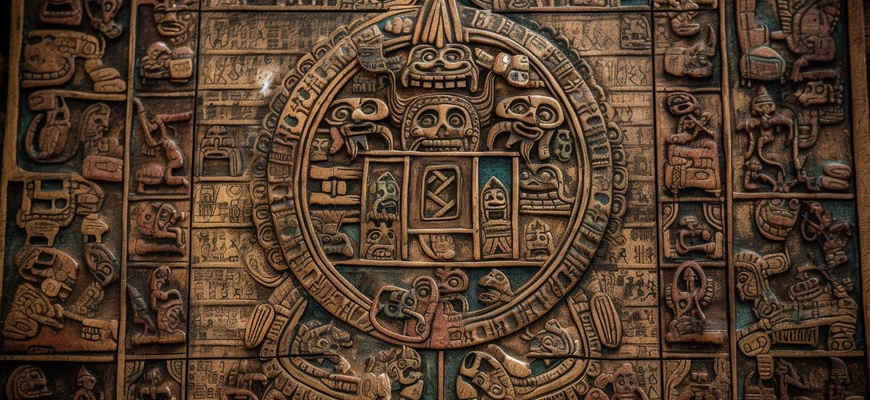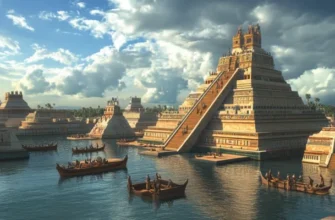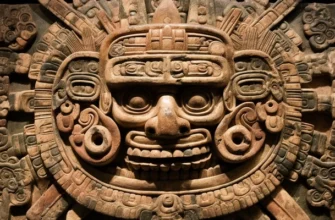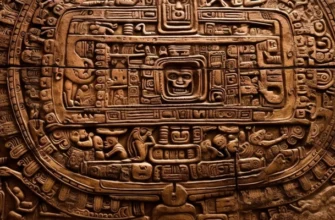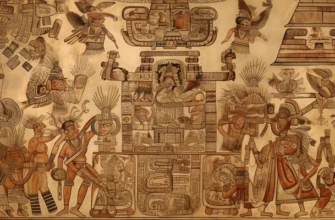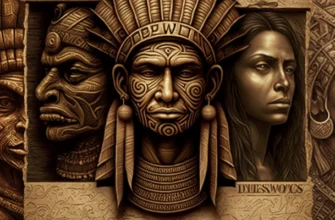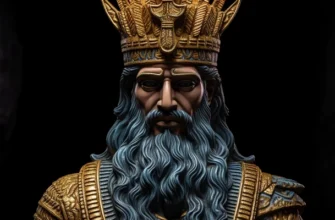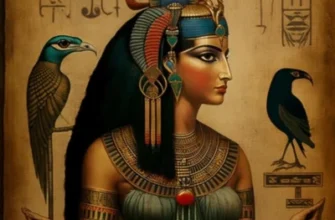The Nahuatl calendar is a traditional calendar used by the Nahua people in Mexico before the arrival of the Spanish. It consisted of two calendars: the solar calendar and the sacred calendar. Each of the calendars had its own cycle of 260 days, as well as a separate cycle of the year depending on the solstices and the change of seasons. The calendar reflected natural phenomena and cultural events, and was important for religious and astronomical ceremonies. Although the Spanish attempted to destroy the calendar, it has remained in modern Mexican culture and is used to celebrate national holidays and religious ceremonies.
- History of the creation and use of the calendar
- Calendar structure and its elements
- It is a solar calendar: “Tonalpohuali”
- It is a sacred calendar: “Tonalamatl”
- The meaning and use of the calendar in Nahua culture
- Astronomical observations and weather forecasting
- The impact of Spanish colonization on the use of the calendar and its preservation in modern culture
- Modern use of the Nahuatl calendar in Mexico and beyond
- Conclusions and future research on the Nahuatl calendar
History of the creation and use of the calendar
The Nahuatl calendar is a timekeeping system that was used by the Nahua people in ancient times in Mexico and Central America. This calendar consists of two different cycles – a 260-day cycle and a 365-day cycle.
The history of this calendar is very old and it is not known when exactly it was created. It was the previous national calendar used in Mexico before the arrival of the Spanish conquerors. It was based on observations of the movement of the sun, moon, and planets.
This calendar was very important to the Nahua people because it determined the rhythms of their lives, including agriculture and religious rituals. In addition, it was also important for making prophecies and predictions.
The Nahuatl calendar system consisted of two cycles. The first cycle, Tonalpohualli, consisted of 260 days and was used to determine a person’s name, characteristics, and destiny. This cycle consisted of 20 days and 13 numbers, and each number had its own name and symbolism.
The second cycle, consisting of 365 days, reflected the various cycles of natural phenomena, such as the change of seasons and the cycle of the earth around the sun. This cycle consisted of 18 months with 20 days each, as well as one month with 5 days.
The Nahuatl calendar was used since ancient times, but its use became limited after the arrival of the Spanish conquerors. The Spanish attempted to replace the Nahuatl calendar with the Gregorian calendar, which is used around the world, but the Nahua people continued to use their calendar, and in some areas it is still in use today.
The modern use of the Nahuatl calendar is popular in Mexican Indian communities, as well as in some academic circles where the history and culture of the Nahua people are studied. The Nahuatl calendar has played an important role in preserving the traditions and cultural values of this people, who have existed for over 2000 years.
Calendar structure and its elements
The Nahuatl calendar consists of two cycles – a 260-day cycle (Tonalpohualli) and a 365-day cycle (Xiuhpohualli).
The Tonalpohualli, or “cycle of days,” consists of 260 days, each with its own name and symbol. This cycle was important for prophecy and divination, as well as for determining a person’s name and destiny.
The Xiuhpohualli, or “cycle of years,” consists of 365 days, which are divided into 18 months of 20 days each, as well as one additional month with 5 days called Nemontemi. Each month has its own name and symbol, which is associated with nature and cultural traditions of the Nahua people.
Another important element of the Nahuatl calendar is the “current day” (tonalpohualli in xihuitl), which is determined by combining one number and one symbol from each cycle. For example, if the number 1 is combined with the symbol of a flower, it means that today is called the “flower day”.
Another important element of the calendar is the concept of “tones,” which is associated with the 260-day cycle. Each tone describes a certain energy or force associated with a particular symbol and is reflected in the mood and events of the day it occurs.
All of these elements, along with the various rituals and ceremonies associated with the calendar, played an important role in the life and culture of the Nahua people, and still remain important to the preservation of their identity and cultural traditions. The Nahuatl calendar was not only a tool for determining time and natural cycles, but also had spiritual significance related to the human connection to nature and the cosmos.
The Nahuatl calendar was also important in the social life of the people. For example, it was used to determine the date of birth and the name of a child, as well as the appropriate time for various events, such as weddings, funerals, harvesting, and others. The calendar was also important for prophecy, particularly for predicting weather conditions, harvests, and other events.
There is also a lot of symbolism in the Nahuatl calendar related to the gods and the cosmos. For example, some symbols and month names are associated with plants, animals, gods, and elements of nature, while other symbols reflect various aspects of the people’s life and spiritual world.
In today’s world, the Nahuatl calendar continues to be used as an important symbol of the Nahua culture and identity. Some organizations and public figures promote the use of this calendar as a way to preserve traditions and cultural heritage. Also, the Nahuatl calendar is a subject of study and research for historians, anthropologists, and other scholars studying the culture and history of the peoples of Mexico and Central America.
It is a solar calendar: “Tonalpohuali”
The Tonalpohuali is a solar calendar of the Nahua people that was used to determine the days of the year and predict weather conditions and natural phenomena.
The calendar consists of two cycles: the cycle of weeks (13 days long) and the cycle of years (260 days long). Each day in this calendar has its own name and symbol that reflect the spiritual and cosmic context of that day. For example, the first day of the cycle, Chikomeztli, represents the beginning of a new life and a new beginning.
Each week in the Tonalpohuali calendar has a name that consists of the week number and the name of one of 20 symbols that repeat throughout the cycle of weeks. These symbols represent different aspects of life, such as flowers, animals, and other natural phenomena.
The cycle of years in the Tonalpohuali calendar consists of 13 years, each with its own symbol and spiritual meaning. For example, the first year of the cycle, Atl, symbolizes water and a new beginning, and the last year, Omeikatl, is associated with grain and harvest.
The Tonalpohuali calendar was of great importance to the Nahua people. It was used to determine various important events such as births, weddings, and funerals. In addition, this calendar was an important tool for augury and prediction of weather conditions and other natural phenomena.
In modern times, the Tonalpohuali calendar is an important symbol of the cultural heritage of the Nahua people and is used as a symbol of national and cultural identity. Some Nahua people continue to use this calendar in their daily lives and during the celebration of traditional holidays.
The significance of each day in the Tonalpohuali calendar is related to cosmic forces and the spiritual relationship between humans and nature. For example, days associated with fire and wind were considered restless and dangerous, while days associated with water and earth were considered favorable for various activities and occupations.
In the Tonalpohuali calendar, there were also special days that were marked by celebration and religious rites. For example, the celebration of a child’s birthday took place on the tenth day after birth, and the Day of the Dead holiday was celebrated at the end of October.
In modern times, the Tonalpohuali calendar is preserved in various forms and is used in many aspects of the Nahua people’s lives. This calendar is proof of the high level of development of this culture and its relationship with space and nature.
It is a sacred calendar: “Tonalamatl”
In addition to the solar calendar “Tonalpohuali”, the Nahua people also used a sacred calendar “Tonalamatl”, which describes the ritual cycle of birth and death. This calendar reflects various aspects of cosmic life and is based on cyclical periods of five days made up of 13 weeks.
In the Tonalamatl calendar, each day has its own symbol representing different aspects of life and spiritual practice. Symbols can be represented in the form of animals, plants, geometric shapes, or other abstract forms. Each symbol has its own meaning, reflecting different aspects of nature and cosmic energy.
The Tonalamatl calendar reflects the Nahua people’s belief that each person is born with their own spiritual identity card that determines their place in the world and their destiny. This calendar also reflects the people’s belief in recarnation, that is, the belief that the soul of a deceased person is reincarnated into another life form after death.
The Tonalamatl sacred calendar is still used by some groups of the Nahua people in their religious rites and cultural practices. This calendar is an important component of the Nahua national heritage and testifies to the high level of development of the spiritual culture of this people.
The meaning and use of the calendar in Nahua culture
The Tonalpohuali and Tonalamatl calendars were of great importance in the Nahua culture. Not only did they serve to determine the time and division of work, but they also reflected the cosmic patterns and mysticism of the world. The calendars helped the Nahua people to practice their religious and cultural customs.
The Tonalpohuali calendar was used to calculate the harvest and conduct religious ceremonies. It allowed them to determine when to sow and reap different crops, as well as celebrate holidays associated with nature deities and the rhythms of the natural world.
The Tonalamatl calendar was used to determine the days favorable for religious and cultural events such as weddings, burials, and religious ceremonies. It was also used to determine dates of birth and other events in a person’s life.
Nahua calendars were also important symbols of their culture. They helped in the maintenance and dissemination of national identities and traditions. The calendars reflected the people’s belief in their deities and the spiritual world, which was an important element in their culture.
Modern Nahua groups continue to use calendars in their cultural and religious practices. They play an important role in preserving and developing the national heritage and maintaining the identity of the Nahua people.
Astronomical observations and weather forecasting
The Nahua used astronomical observations to determine the calendar and predict weather patterns. They followed the movements of the sun, moon, and stars, which helped them accurately determine time and calendar dates. They also had knowledge of various astronomical phenomena, such as eclipses and starfalls.
In addition, the Nahua people used natural signs to predict the weather. They observed the behavior of animals, such as insects and birds, as well as changes in nature, such as clouds, wind, and temperature. They also used their knowledge of celestial phenomena to predict the weather based on the movements of the sun, moon, and stars.
Modern Nahua groups continue to use their traditional methods of weather forecasting. They observe animal behavior and natural signs, and use modern meteorological methods to make more accurate predictions. Knowledge of astronomy and weather is an important element in the Nahua people’s culture and traditions, which they practice to this day.
The impact of Spanish colonization on the use of the calendar and its preservation in modern culture
Spanish colonization had a significant impact on the use of the calendar and its preservation in Nahua culture. The Spanish colonizers viewed the Nahua traditions with great ambivalence and tried to curb them. One of the ways the Spanish tried to establish control over the people was to replace the traditional calendar with the Catholic one.
The Spaniards introduced the use of the Gregorian calendar, which is based on the Roman calendar and differs from the traditional calendar of the Nahua people. This resulted in the traditional Nahua calendar being denied and virtually forgotten. However, some Nahua groups continue to preserve their traditional calendars and use them for their festivals and rituals.
The Nahua people were also forced to adapt to the Christian religion promoted by the Spanish. Christian holidays, such as Christmas and Easter, became important to the Nahua people, and their traditional holidays and rituals were changed or forgotten. However, in some regions of Mexico, the Nahua people have managed to preserve their traditional holidays and rituals and resume the use of their traditional calendar.
In today’s Nahua culture, the traditional calendar is preserved and used in various festivals and rituals. It is an important element of the Nahua national identity and cultural heritage. Some Nahua groups use the traditional calendar to set dates for holidays and rituals, to predict the weather, and to make various astronomical observations.
The Nahua traditional calendar has also survived in the academic sphere, where it is studied as an important source for research on Nahua culture and astronomy. Both scholars and people interested in the history and culture of the Nahua people show considerable interest in the traditional calendar.
In the modern world, the traditional Nahua calendar is used not only in Mexico but also in different parts of the world. For example, in the United States, the Nahua traditional calendar is used to hold various events related to the culture of the Nahua people, as well as to popularize astronomy and the history of the Nahua people. Thus, the traditional Nahua calendar is not only preserved in the culture of the Nahua people, but also has significance for the whole world interested in the culture and history of this people.
Modern use of the Nahuatl calendar in Mexico and beyond
Today, the traditional Nahua calendar is used in Mexico and abroad for various events related to the Nahua culture, as well as for celebrations and rituals. The Mexican state of Veracruz annually celebrates the Day of the Dead according to the traditional Nahua calendar, which includes various religious and cultural rituals. In Mexico City, the Nahua Calendar Festival is held every year, which presents various aspects of the traditional Nahua calendar, including various astronomical observations and holiday schedules.
The traditional Nahua calendar is also used on modern farms in Mexico to predict the weather and determine when to plant and harvest crops. In some regions of Mexico, the traditional Nahua calendar is used for religious and cultural events related to the traditions of the Nahua people.
Outside of Mexico, the traditional Nahua calendar is used for a variety of events related to the Nahua culture. In the United States, for example, the traditional Nahua calendar is used for various events aimed at preserving the cultural heritage of the Nahua people and popularizing their history. Such events include conferences, exhibitions, music festivals, and other cultural events.
One of the most famous events related to the use of the Nahuatl calendar is the “Day of the Dead” (Dia de los Muertos), which is celebrated in Mexico and other Latin American countries on November 1-2. This holiday is associated with the local tradition of honoring ancestors and celebrating their lives, and the Nahuatl calendar is used to determine the date of the celebration.
The Nahuatl calendar also remains an important element of Nahua culture in Mexico and beyond. For example, in 2015, a large Wheel of Time monument was erected in Mexico City, which displays the Nahuatl calendar. This monument has become a prominent symbol of the city and its cultural heritage.
In addition, the Nahuatl calendar is used in many other aspects of Mexican culture, such as art, music, and literature. For example, the famous Mexican artist Frida Kahlo used the Nahuatl calendar in her work, and in music, many songs are dedicated to the celebration of the Day of the Dead.
Thus, the Nahuatl calendar remains an important component of Nahua culture and Mexican culture in general, inspiring creativity, promoting the preservation of traditions, and serving as a reminder of Mexico’s ancient history and culture.
Conclusions and future research on the Nahuatl calendar
In conclusion, the Nahuatl calendar is an important element of the Nahua culture and Mexico in general, which has a long history and many different functions. This calendar consists of two parts: solar and sacred, which are used for various purposes, such as weather forecasting, determining days of celebration, and setting the date of important events.
At the end of the 16th century, the impact of Spanish colonization led to the destruction of many sources of knowledge about the Nahuatl calendar, but now there are many efforts to preserve and revive this calendar. Today, the Nahuatl calendar is used for many purposes in Mexican culture, including the celebration of the Day of the Dead, art, music, and literature.
Future study of the Nahuatl calendar should include research into its impact on Mexican culture, as well as research into the technology and knowledge that was used to create and maintain this calendar. It is also important to preserve the Nahuatl calendar and make it available to future generations in order to preserve Mexico’s historical and cultural heritage.
